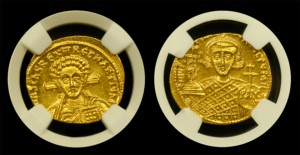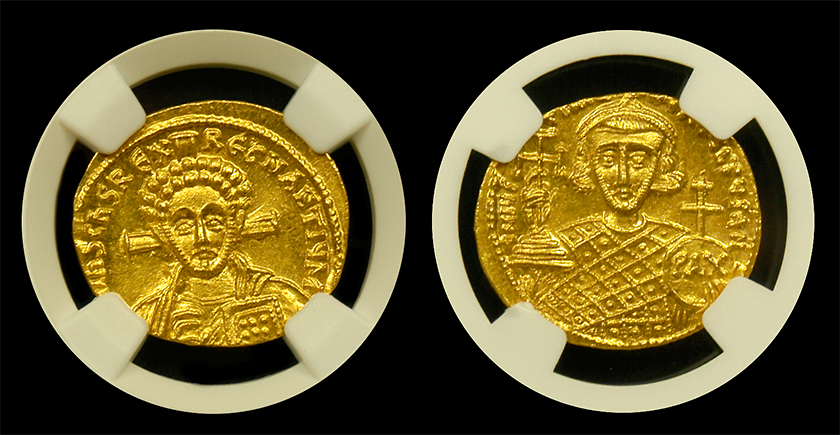
Struck between 705-711 A.D., this spectacular gold coin was issued during the second reign of Justinian II. It is the depiction of Christ on a coin and is highly desirable as a result. This coin often comes very softly struck, however, this particular example is razor-sharp with remarkable detail on both sides of the coin. In fact, Gem Mint State is the highest grade awarded by NGC Ancients making this the finest known certified example available in the world today.
The obverse depicts a youthful portrait of Christ holding the scripture with a cross behind his head. The reverse depicts Justinian wearing a crown and in one hand holding a globe with the word “pax” or peace. In the other hand he holds a cross. We typically encounter these coins in lower grades, this particular example is noteworthy and very desirable.
The Byzantine Era
The Byzantine Era, which spanned from 330 AD – 1453, was a tumultuous period in human history. During this turbulent time there was a rapid expansion of Christianity across broader Europe. It was the only structured state that existed uninterruptedly from antiquity till the dawn of the modern era west of China and into Central Europe.

The Byzantine Empire was the most influential political, cultural, and military force in Europe for the majority of its history, and over time there were multiple cycles of economic growth and fall. A religious revolution was also in its infancy as Christianity began to take hold.
The Byzantine Era witnessed a transition from Roman Polytheism (the belief in many different gods like Zeus and Athena) to Christianity. Coinage during this time frame is highly desirable, particularly examples struck in gold that have been preserved in high grades. Today these interesting coins referred to as gold Solidus’, offer a nice combination of historical significance, beauty, and a relatively high gold content.
As with earlier Roman coins, the early Byzantine coins followed the late Roman conventions of showing the head of the Emperor on the obverse side, except now full face rather than in profile. The cross or an angel would typically be present on the reverse side as a Christian emblem.
Justinian II puts Depiction of Christ on a Coin
By the time Justinian II became emperor he started putting depiction of Christ on a coin. For instance, Christ on the obverse and a half or full-length portrait of the emperor to the reverse. Christianity was increasingly spreading throughout the Eastern Roman (Byzantine) Empire. However, a notable change started to occur in 695 AD. A government led iconoclasm began destroying religious icons and monuments with religious or political motives.
Some accepted that an Old Covenant interpretation of The Ten Commandments. Consequently. The Ten Commandments served as theological justification for the outlawed creation and worship of “graven images.” Adjustments to Orthodox worship needed to mirror the significant social and political upheavals of the Byzantine Empire in the seventh century. The iconoclasm was also brought on by Caliph Abd al-Malik who decided to utilize only Islamic money with lettering. Therefore, changing rather than continuing prior acceptance of Byzantine coin types.
Iconoclastic riots took place all the way into Zürich, Copenhagen, Munster, Geneva, Augsburg, Scotland, and most of today’s Northern Europe. Soon a political and economic division occurred in Byzantine society. The Eastern, less wealthy, non-Greek peoples, mainly favored iconoclasm. The people of the Balkan and Italian provinces, as well as the wealthy Constantinople Greeks, were the ones fiercely opposing iconoclasm.
As time went by Byzantine coins became thinner and wider to the point that they became as thin as wafers. In fact, they could even be bent by hand. Even though changes were dramatic and chaotic, Byzantine coinage lasted until the end. To clarify, full-faced ruler portraits continued adorning the obverse with the depiction of Christ on a coin like they did in the beginning of the great Byzantine Empire.
Click here for Byzantine Gold Coin Inventory

